I was on my way to my uncle's funeral, a much loved uncle who contributed more to my plant knowledge than most anyone else. He's the one who told me about hybridizing years before hybrid was a common word in gardening circles. He's also the one who gave me my first dark red daylily back in 1974. Until then I had only the old orange ditch lilies and a few others my Ninna had given me. He brought it with him when he drove about 220 miles to visit and planted it while he was here. The dark red was a real treasure that still blooms every year in my garden.
I was driving the same 220 miles on the interstate to pay my last respects to him this week, when I suddenly saw a huge field of red flashing by. It's May, after all, and I had already seen fields of green and some of yellow, but the red surprised me. I thought at first it might be tulips, but late May is too late for tulips in Kentucky and no one would take the time to plant thousands of tulips along an interstate anyway. I realized it was something growing, not in a field, but around an area where new ramps recently had been built. There is a lot of ongoing road construction and I was dodging heavy winds and raindrops, orange cones, and interstate traffic; I didn't have time to think of fields of red.
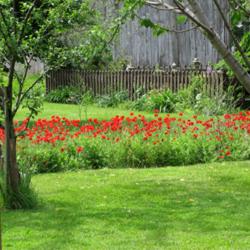
|
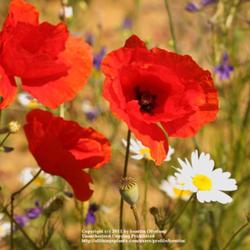
|
But I kept seeing them, here and there, in places where nothing else grew, in areas where construction had been; fields and fields of red.
It was a bittersweet trip. My uncle was my mentor, my friend, and my heart was a little heavy. I continued to drive when suddenly, as bright as the lightning flashing around me, I remembered the May morning years ago when we looked out at our field of recently planted corn to see little patches of red here and there along the edges of the cornfield. He said, "In Flanders Fields the poppies blow . . ."
That was my introduction to Papaver rhoeas.
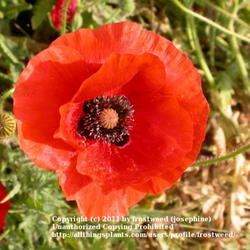
|
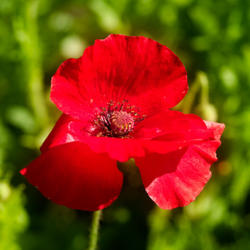
|
And it was my introduction to the artistic, literary, poetic side of my uncle, a physician, a pediatrician; the one who'd helped heal many, many children both physically and emotionally. He recited the poem, and after the last line, he casually mentioned that it had been written by another physician during the battles of WWI. Then just like Aunt Bett, his aunt as well as mine, he taught me a lesson about plants and nature and about life. I'll share a little of what I remember with you.
The popular field poppy has unknown origins. We attribute them to Europe usually, but Europeans mostly say the poppy came from North Africa, where the earliest forms of agriculture were practiced. It's considered a weed, but one that provides nutrients to depleted soil. The amazing thing about the field poppy is that it is an annual and it forms its own long-lived soil seed bank; it can germinate after many years of dormancy when the soil around it is suddenly disturbed. It's thought that it was used as an agricultural crop hundreds of years ago. Its latex base is mildly toxic to grazing animals (they don't usually eat it), so it would only have been used to replenish soil drained of nutrients. Some say it might have been the source of a mild sedative, though one not nearly as strong as the opium derived from its relative, Papaver somniforum.
Similar to other Papavers, the large bloom of the field poppy usually has four petals that are vivid red, and frequently some of them have a very tiny black spot at their base. The slightly droopy bloom grows on a tall, slim stalk, one that seems too weak to hold such a large bloom. In windy weather, the bright red blooms appear to be bouncing and waving. That's what I saw when I drove along the interstate, a waving field of bright red.
During WWI the poetic physician, Canadian Lieutenant Colonel John McCrae, noticed that even in the extremely stricken and depleted ground of warfare, an abundance of field poppies grew from it after the soil had been disturbed. There were areas in which soldiers had been buried in the fields where they were slain, and over their graves the field poppies grew and bloomed. It was during that time that McCrae wrote the poem, In Flanders Fields, as he gazed over battlefields turned into burial grounds early on a warm May day in 1915.
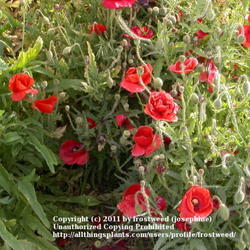
|

|
The field poppy has since been named the Memorial Flower, largely through the efforts of an American professor, Moina Michael, 'The Poppy Lady.' She came across McCrae's poem in November 1918 just before the Armistice was signed. His heartfelt words led her to begin collecting little artificial red poppies and distributing them in the United States as a symbol of remembrance of fallen soldiers. Finally in 1920, her efforts were rewarded when the American Legion adopted the memorial poppy and began distributing it. You know the rest of the story. The tribute in the United States will soon be one hundred years old. In other countries it is even older.
So during this history lesson, I asked my Uncle Bill about poppy seeds and opium. I surely did not want our cornfield to be raided by government agencies looking for illegal plants. He assured me that poppy seeds and opium come from Papaver somniferum. Good. Our field of poppies was legal and safe and although that was a few years ago, it's possible the poppies are still blooming around our cornfield.
I'm pretty sure all those poppies I saw growing along the interstate throughout my trip were not solely the work of Mother Nature. I'm also sure that the poppies were sown by people who knew that very little would grow in soil left infertile by road construction. Field poppies will grow almost anywhere and their seeds, though long buried, will be viable for many years.
Sometimes early lessons aren't fully learned until we are older. When the timing is right, when we see fields of red blooming in places where nothing can easily grow, when the words of a poem learned long ago fill the corners of our minds, then it all falls into place. Field poppies will grow where nothing else will; like people, they will adapt.
The power of haunting words and the beauty of fields of red, both appearing out of nowhere, can be quite stunning, much like a sudden flash of lightning and a harsh clap of thunder and a memory that I thought was long forgotten.
| Thread Title | Last Reply | Replies |
|---|---|---|
| What a sad irony in this post... by DogsNDaylilies | Aug 6, 2017 7:42 AM | 0 |
| How could I have missed this? by TBGDN | Feb 15, 2016 8:25 PM | 4 |
| Enjoyed this article! by CarolineScott | Aug 17, 2015 1:32 PM | 1 |
| Flanders field. by KAMasud | Mar 7, 2014 9:32 AM | 9 |
| Beautiful and touching by BookerC1 | Jun 11, 2013 11:32 AM | 7 |
| No poppies in the South by hazelnut | May 31, 2013 5:03 PM | 7 |
| The poem and another! by NEILMUIR1 | May 27, 2013 10:45 AM | 1 |